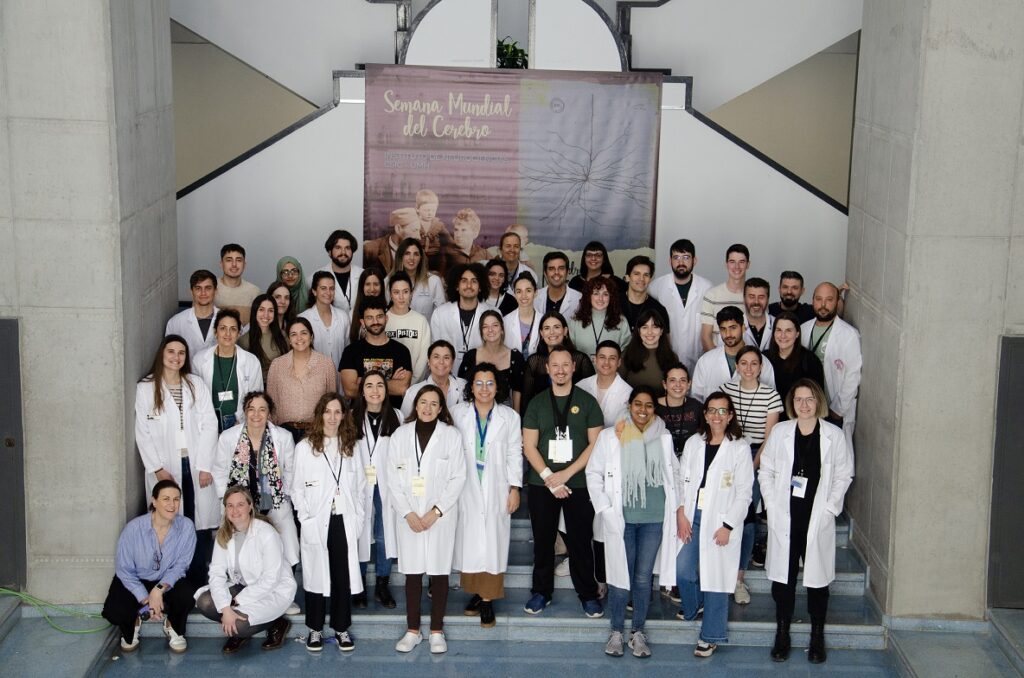More than 3,000 people have visited the Brain Awareness Week 2024 of the Institute for Neurosciences CSIC-UMH 2024
21 de March de 2024
- More than 130 IN volunteers have dedicated themselves to make a success of this Brain Awareness Week edition.
For yet another year, the Institute for Neurosciences (IN), a joint center of the Miguel Hernández University (UMH) of Elche and the Spanish National Research Council (CSIC), has celebrated Brain Awareness Week to bring closer the importance of basic research in neurosciences to the general public. From March 11 to 15, several open days took place in the Francisco Javier Balmis building of the UMH Sant Joan d'Alacant campus, in which IN researchers presented the science they carry out in their laboratories to share it with all attendees through an extensive program of activities, exhibitions, informative mini-talks, educational workshops and a round table on Artificial Intelligence.
Throughout the week, more than 2,500 students from different centers in the Valencian Community have visited the campus to learn about the research on the brain and the Central Nervous System that is carried out at the IN through the stand numbers that make up the program and the different informative mini-talks that were given each day. In addition to the scheduled visits for schools, three sessions were opened to the general public in the afternoon and were filled until closing time.

Photo: Brain Week Volunteers , Institute of Neurosciences 2024
This edition has been a success thanks to the participation of more than 130 volunteers, among whom there were both researchers and technicians, who carried out educational workshops on topics such as animal models used in research, sensory illusions, anatomy of the brain, or the mysteries of our DNA, among many others.
Attendees were able to visit three exhibitions in parallel to all the activities. The first was the artistic exhibition 'Scientific Photography of the IN' composed of high-resolution prints that represent the different lines of research carried out at the IN. The second exhibition was '#HicieronHistoria’ from the UMH BEATRICS project, composed of a series of totems, available in Spanish, Valencian, and English, about the scientific and technical milestones of several women from different fields and historical moments. And, finally, 'Human Brain Photo Expo', a photographic exhibition from the Department of Histology and Anatomy of the UMH dedicated to the central nervous system, was inaugurated with an informative talk by IN researcher Salvador Martínez.
Another novelty of this edition has been the incorporation of workshops with three-dimensional sculptures that explored the neuroanatomy of different animal species. This collection was complemented by detailed representations of various neuronal types and cells of the nervous system along with several drawings by Santiago Ramón y Cajal. This is an activity adapted for people with visual disabilities through Navilens labeling in which attendees were also able to use glasses that simulated visual pathologies. This workshop has been carried out in collaboration with the professor of the Cellular Biology Area of the UMH Eduardo Fernández Jover, the Institute of Bioengineering of the UMH, the Technical Support Service for Teaching and Research (SATDI) of the UMH, and the company Instead Technologies for Helping People SL.
Likewise, with the support of the Chair of Neurobiology Remedios Caro Almela, a new edition of the 'Cerebro y Sociedad' cycle was held with the round table ‘Máquinas que nos ayudan: Encuentro entre Inteligencia Artificial y Neurociencias’, which took place on the 12th March at the Espacio Séneca in Alicante. The event included Antonio Pertusa, who directs the University Institute of Computer Research at the University of Alicante (UA); Carmina Díaz Marín, head of the Neurology Service at the Dr. Balmis General University Hospital; and Joaquín Ibáñez Ballesteros, director of the Department of Physiology at the UMH and co-founder of the spin-off Newmanbrain. It was also moderated by IN researchers Santiago Canals, who leads the Plasticity of Brain Networks laboratory, and Silvia De Santis, who leads the Translational Imaging Biomarkers laboratory.
The researcher and coordinator of Brain Awareness Week, Juan Antonio Moreno Bravo, highlighted that this event has been “a magnificent opportunity for citizens to be in contact with researchers and to learn first-hand how they work to contribute to the advancement of knowledge”. “In addition, the fact that so many students visit us allows us to promote scientific vocations among the youngest, motivating their curiosity and breaking down stereotypes about the scientific profession," said the researcher.
The director of the Institute for Neurosciences, Ángel Barco, has highlighted the involvement of the institution's staff in the implementation of this initiative: “It is a pride to see how year after year all the staff go out of their way to share their work. with everyone who comes to visit us. “The commitment and effort shown by both the researchers, the technical staff, the volunteers, and the students is total so that Brain Awareness Week becomes a benchmark for the city of Alicante”.
Brain Awareness Week has the collaboration of the Remedios Caro Almela Chair of Neurobiology, the Vice-Rectorate of Research and Transfer of the UMH, the Dana Foundation, and Leica Microsystems. Additionally, accessible outreach activities are part of the initiative ‘La Semana del cerebro del IN: Neurociencias sin barreras’ and are part of the CSIC Scientific Culture Network project financed by the Fundación Española para la Ciencia y la Tecnología (FECYT) – Ministry of Science, Innovation and Universities.
More information: https://semanadelcerebroin.umh.es/
Source: Institute for Neurociences UMH-CSIC (in.comunicacion@umh.es)

 Español
Español